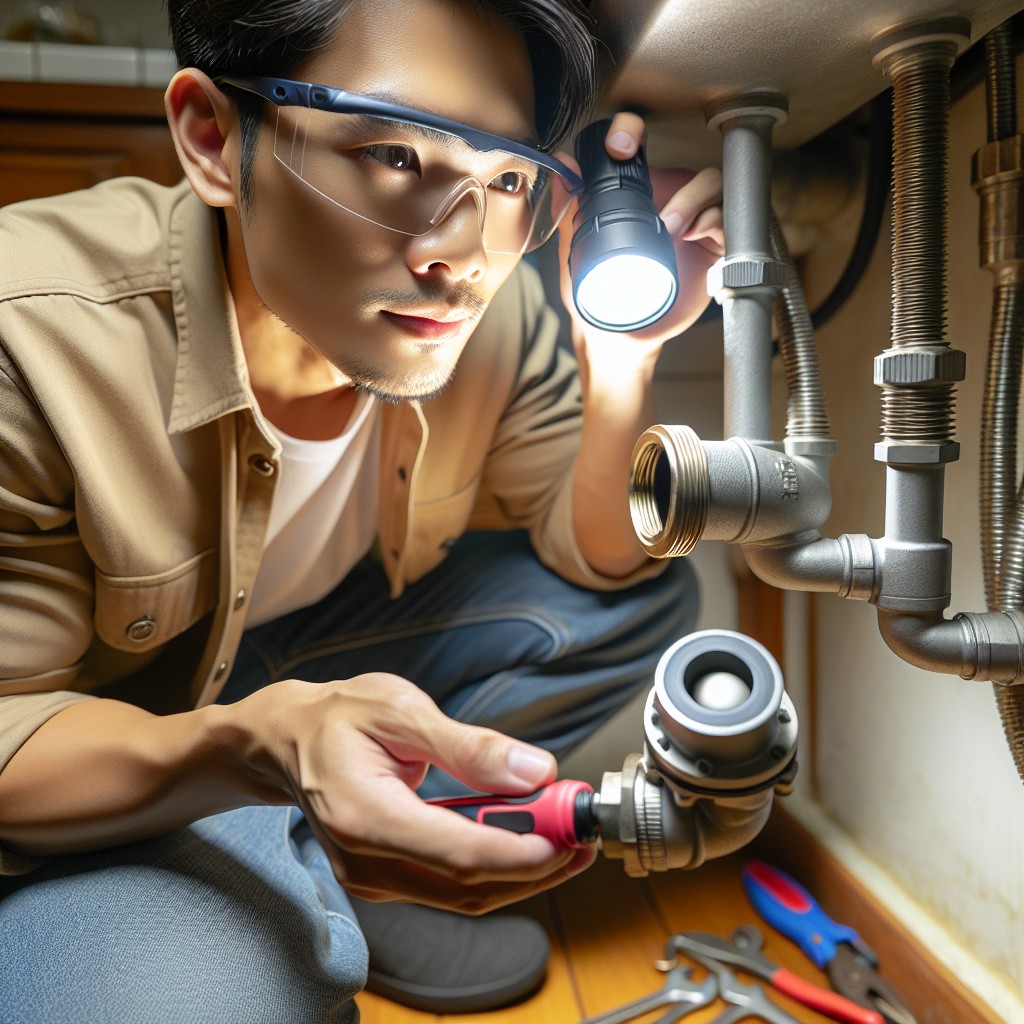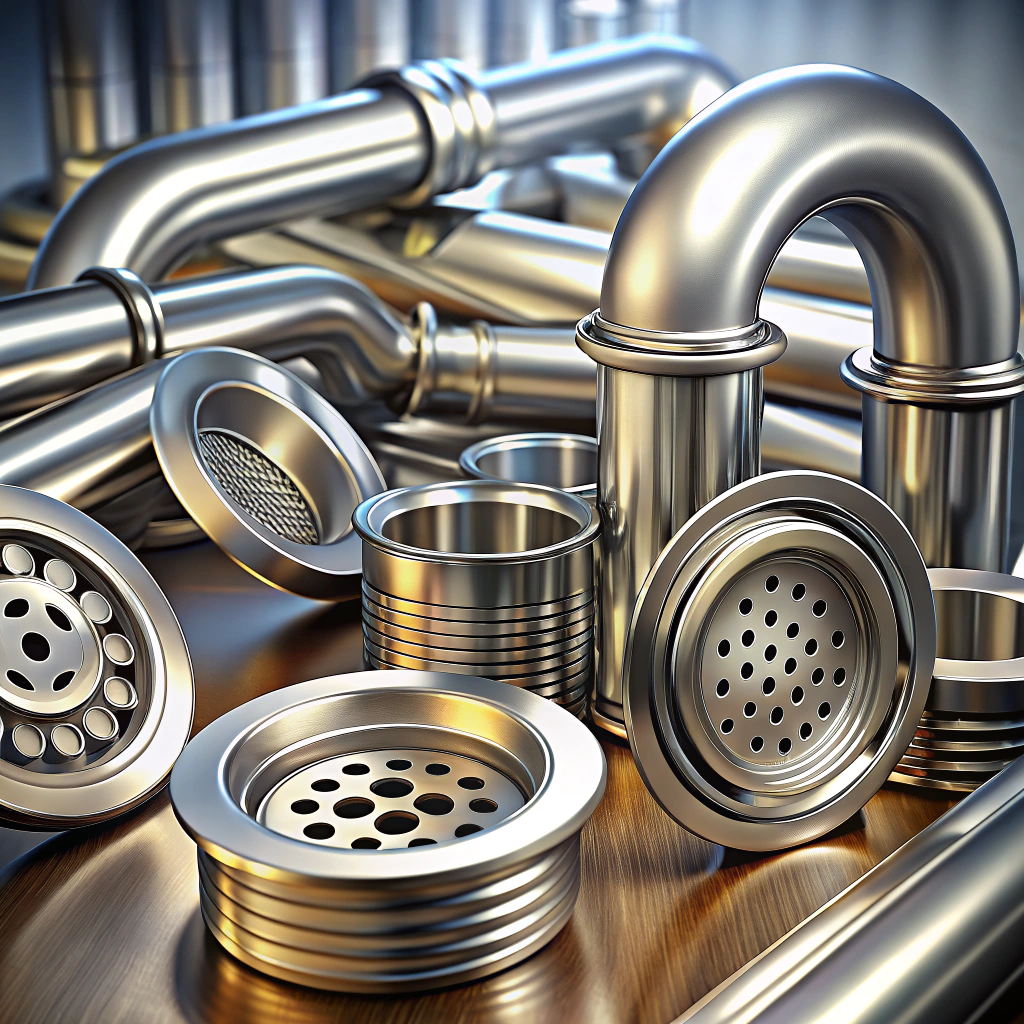Last updated on
Discover how to fix the pesky airlock in your kitchen sink drain, because this common issue can cause unnecessary stress and disruption to your daily routine.
Airlocks in kitchen sink drains are not an uncommon occurrence, but the good news is, they’re relatively easy to fix. To remove an airlock, you’ll need a cup plunger and a bit of persistence. Firmly place the plunger over the drain, ensuring an airtight seal. Swiftly push down and then pull up, repeating this a few times. This rapid change in pressure often dislodges an airlock.
But if you’re dealing with a stubborn airlock, there’s no need to fret. This is just a brief overview, so read further to understand the step-by-step process, along with other valuable tips on how to handle more complex airlock situations.
Key takeaways:
- Locate and inspect the Air Admittance Valve (AAV)
- Perform a test to check if the AAV is functioning properly
- Remove the P-trap and inspect for blockages
- Connect hot and cold water faucets to release airlock
- Use a hosepipe to force out trapped air
What's Inside
Locate Your AAV

The Air Admittance Valve (AAV) usually found under the sink is the first step towards solving the puzzle. Often, it is attached to the sink drain or towards the end of your vent pipe. A proper visual examination should help you locate it.
Remember, an AAV can vary in size, with the standard ones being about 4.3 inches tall. After location, ensure the valve is clean and dust-free to allow proper functioning. So, put on your detective lenses and get searching for the AAV!
Inspect the AAV

To begin the inspection, manually remove your air admittance valve (AAV). This is typically located on, or near, your sink. If it’s high, you might require a step stool for access. The AAV is often covered by a plastic or metal cap, which can be unscrewed for removal.
Once you’ve exposed the AAV, take a closer look. A functioning valve should not have any visible damage, the spring should feel robust, and the internal seal should be airtight. Any signs of rust, decay, or deterioration could indicate a compromised valve, which would contribute to an airlock situation. Finally, perform a smell test. A properly working AAV shouldn’t exude any strong odors, as the seal should keep foul air contained. If things look, feel, or smell suspicious with your AAV, consider replacing it.
Remember, the AAV is a crucial part of your plumbing system. Ensuring its good health is instrumental in keeping your sink’s drainage free from troublesome airlocks. Seek professional help if you’re uncomfortable assessing or replacing the AAV yourself.
Perform an AAV Test
To determine whether your AAV is functioning as required, perform a simple test. Initially, run water down the sink to induce a standard flow, observe if there remains a significant slowdown or undesired backup. Another way is to lightly tap the valve; if you sense any rattling, this hints towards internal damage which, too, can cause an airlock. Lastly, attempt removing the AAV; typically, it should unscrew effortlessly. If met with resistance, an airlock might be the culprit. Remember, this test merely indicates potential issues, it doesn’t confirm an airlock. Detailed inspection is required to confirm airlock issues.
Remove the P-trap and Drain
Begin by placing a bucket underneath the P-trap, the U-shaped section of the drain, to catch any residual water.
Loosen the slip nuts using channel-lock pliers and remove the P-trap from the sink drain.
If the sink has a garbage disposal unit, ensure to disconnect it from the rest of the assembly before proceeding.
It’s important to be gentle to avoid causing any damages.
Once removed, carefully inspect the inner parts for any noticeable blockages, which may need manual removal or cleaning before reinstallation.
Connect the Hot and Cold Water Faucets
To combat an airlock, connecting hot and cold water faucets yields impressive results. Firstly, locate the faucets in your home, ideally ones that are close together or share a common wall.
Here’s a simple step-by-step guide:
- 1. Start by turning off both faucets.
- 2. Connect a hose from the spout of the hot faucet to the cold one. Ensure the connection is tight.
- 3. Turn the cold water on slowly, but leave the hot water tap off. The pressure from the cold water line will then push the airlock out of the hot water line.
- 4. Let the cold water run for about five minutes or until water starts to flow out from the hot water tap.
It’s crucial to be patient, as sometimes it could take up to ten minutes for the blockage to clear especially in extreme cases. Additionally, accuracy in executing each of these steps is essential to ensure the method is effective.
Remember, safety should always remain a priority. Therefore, do not attempt this method if you’re uncertain about how it works. Instead, seek professional help to avoid damaging your plumbing system.
Use a Hosepipe to Release the Airlock
Having interconnected the hot and cold water faucets, the next crucial step involves employing a hosepipe. You’ll need a regular garden hose for this method. Make sure you tightly fit the hosepipe onto the outlet end of the tap with the airlock.
Now, put the other end of the hosepipe onto the hot water tap, making sure it’s also appropriately fixed. The idea here is to create a direct link between the two faucets. Once this is done, turn on the hot water tap. The pressure and heat from the hot water will force the trapped air out of the system, hence releasing the stubborn airlock.
Keep in mind that the process should be done for about 20 minutes to ensure all the air is effectively expelled. Once completed, turn off the faucets and disconnect the hosepipe. Check the flow of water in each tap thereafter – a proper flow indicates that the airlock has been successfully resolved.
Identifying Signs of an Air Lock in Your Plumbing System
Keep an eye out for the following indicators in your piping system to help you recognize an airlock.
1. Irregular Flow: If the water in your pipes isn’t flowing smoothly but spurting out, it could be due to an air lock.
2. Reduced Pressure: Often, one of the most apparent signs is water pressure that is lower than usual.
3. Noisy Fixtures: Another clue is if you hear gurgling or sloshing noises when turning on the taps or flushing the toilet.
4. Fluctuating Temperature: An unexpected and rapid change in water temperature can also signal the presence of an airlock.
By paying close attention to these aspects, spotting an airlock should be a breeze!
Addressing Stubborn Air Locks
While most airlocks can be resolved with basic methods, some might prove more challenging. In such circumstances, certain strategic steps might help overcome the issue.
One approach is to employ a plunger. Specially designed for drains, this tool could be effective against stubborn airlocks. Remember to ensure a good seal and apply considerable pressure when plunging to maximize efficiency.
Alternatively, consider using a commercial drain cleaner. It’s important to follow the package instructions diligently to avoid damage to your plumbing.
However, remember that consistent airlock issues might indicate a larger problem, like pipe configuration errors or significant blockages. In such scenarios, it’s advisable to consult a professional plumber.
Utilizing specialized tools, plumbers can conduct a detailed examination, ensuring the root cause of the airlock in the kitchen sink drain is identified and effectively resolved. This way, you can avoid similar issues down the line, keeping your plumbing running smoothly and efficiently.
Understanding the Concept of an Airlock in a Drainage System
An airlock in a drainage system happens when air gets trapped in the pipes, obstructing the flow of water. This phenomenon usually results from improper venting or a sudden change in water pressure. Imagine it as a bubble, stuck and preventing water from passing through, much like a traffic jam in a busy city.
The typical indications of airlock are gurgling sounds or slow drainage. It’s crucial to fix any airlock promptly as prolonged blockages can cause severe damage to your pipes and even lead to leaks. Don’t worry, though – you can apply simple methods, such as using a hosepipe or hot water, to fix this issue. With the right information and a bit of patience, you can transform your lifeless sink to a flowing stream in no time!
Get Professional Help for Unresolved Airlocks
Once all of the initial steps have been followed with no success, it’s time to consider professional assistance. A licensed plumber has the expertise and the proper tools to deal with stubborn airlocks that refuse to budge. They are trained to identify the root cause of the issue, so they can provide a long-term solution rather than a temporary fix.
Here are a few key points to remember:
- 1. Professionals can save time and money in the long run, preventing damage caused by improper do-it-yourself techniques.
- 2. A skilled plumber can advise about potential problems that may escalate if not addressed immediately.
- 3. If the airlock is an indication of a major issue in your plumbing system, only a professional can accurately diagnose and rectify it.
So, don’t hesitate to call a licensed plumber for stubborn airlocks – it’s a wise investment in the health of your home’s plumbing system.
FAQ
Can a kitchen sink drain get air locked?
Yes, a kitchen sink drain can get air locked, typically indicated by slow-draining sink drains due to a lack of free-flowing air in the plumbing venting system.
How do I get air out of my kitchen sink drain?
To remove air from your kitchen sink drain, shut off the main water supply, then open all faucets about ½ turn – both hot and cold – and run both the dishwasher and the laundry.
How do you clear an airlock in a drain pipe?
To clear an airlock in a drain pipe, pour a pipe-cleaning solution like Liquid Plummer down the overflow opening to unclog the connecting tube, thereby enabling proper water flow and drainage.
Why is my kitchen sink draining slowly not getting air?
The slow drainage of your kitchen sink may be due to a clogged plumbing vent, which regulates air pressure in your plumbing system and, when blocked, can slow down the flow.
What are the signs of an airlock in a kitchen sink drain?
Signs of an airlock in a kitchen sink drain include slow draining, gurgling noises, unpleasant odors, and the presence of water pooling around the drain.
Will an airlock in a kitchen sink drain lead to permanent damage if not addressed?
Yes, an airlock in a kitchen sink drain can lead to permanent damage if not addressed, as it can cause undue pressure on the pipes and lead to leaks or breakage.
Are there specific tools required to clear an airlock from a kitchen sink drain?
Yes, to clear an airlock from a kitchen sink drain you’ll need a plunger, a plumber’s snake, or a hand auger for stubborn blockages.




